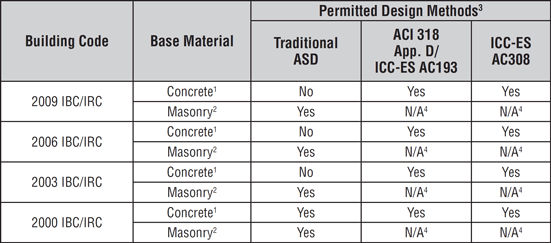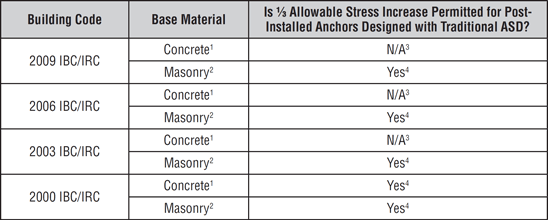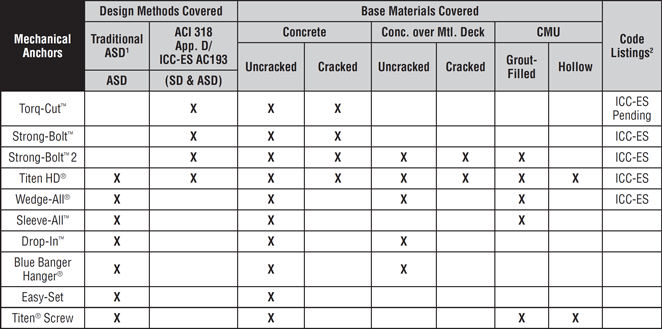Structural Post-Installed Anchor Design Methods Permitted by Building Codes

- "Concrete" includes all concrete base materials such as concrete on metal deck and precast concrete shapes.
- "Masonry" includes all masonry base materials such as hollow and grout-filled CMU and unreinforced brick masonry.
- Code interpretations vary. Confirm with the local Building Official.
- Not applicable since masonry is beyond the scope of this design method.
Building codes and material standards have traditionally allowed Designers to take a one third allowablestress increase on the calculated design capacities of some building materials and components when designing for forces generated from wind and/or seismic events. Newer codes and standards only allow the allowable stress increase to be taken when using an alternate set of load combinations. The table below summarizes when allowable-stress increases are permitted.
1/3 Allowable-Stress Increase for Structural Post-Installed Anchors

- "Concrete" includes all concrete base materials such as reinforced concrete, concrete on metal deck and precast concrete shapes.
- "Masonry" includes all masonry base materials such as hollow and grout-filled CMU and unreinforced clay-brick masonry.
- Not applicable since this code does not use traditional ASD for post-installed anchors.
- Only when indicated in the applicable load table in this catalog and when alternative basic load combinations as prescribed in the code are used..
Structural Post-Installed Anchor Selection Guide

- Allowable loads for traditional ASD are derived from applicable test methods such as ASTM E488, ASTM E1512 and legacy ICC-ES acceptance criteria AC58 and AC60.
- Code listings may not be available for all products/applications cited in the table. To verify code listed products/applications refer to code reports or contact Simpson Strong-Tie.
- Installed into top surface.
- Unreinforced clay brick masonry

- Allowable loads for traditional ASD are derived from applicable test methods such as ASTM E488, ASTM E1512 and legacy ICC-ES acceptance criteria AC01, AC70, and AC106.
- Code listings may not be available for all products/applications cited in the table. To verify code listed products/applications refer to code reports or contact Simpson Strong-Tie.
